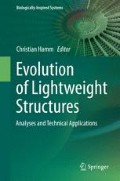Abstract
It is generally acknowledged that living organisms have developed powerful solutions for the challenges posed by environmental factors. These solutions are often more efficient than comparable technical solutions, as they are optimized by an evolutionary process (which takes millions of years) and elegantly integrate diverse functions in a single structure. In the case of stable lightweight constructions, such principles can be found among the exoskeletons of diatoms and radiolarians, which are the most prominent components among unicellular planktonic organisms.
Bionic transfer of such plankton structures to the technical world is, especially if developed by architects and designers, often based on an intuitive selection from the large variety of biological forms. The results—buildings, vehicles or articles of daily use—are beautiful and interesting, but often not really optimized, as systematic adaptations to the technical load cases are missing. In contrast, approaches developed by engineers extract mechanical principles of natural lightweight structures and transfer them to technical solutions. These solutions are usually adapted to the technical requirements (load cases, materials) but they still depend on arbitrary choices from the vast pool of biogenic structures. Therefore the results have a strong random component and it is not clear how well the lightweight potential of a certain object has been exploited. In contrast, natural lightweight forms, especially the shells of planktonic organisms (diatoms, radiolarians, coccolithophorids and acantarians) combine a strict adaptation to performance (mechanical strength, light weight and permeability) with a peculiar beauty, and exist in a large variety. Their adaptation to new challenges is achieved efficiently by the evolutionary process.
In order to achieve a similar degree of adaptation as is present in biogenic structures, the ELiSE lightweight process was developed as a systematic 5-step procedure: This includes (1) a precise technical specification of a lightweight component including e.g. load cases, materials, and manufacturing restrictions, (2) a selection of powerful archetypes identified from biological databases using similarity search algorithms and a mechanical assessment of these models using Finite Element Analyses, (3) the abstraction of natural design principles to digital concept models using CAD and novel tools, (4) a structural adaptation using optimization tools such as Evolutionary Strategic Optimization, and (5) the final design which combines bio-inspired structures, results of optimizations routines and realistic manufacturing methods to produce an optimized part. Here we show how the ELiSE method relates to the natural evolutionary process and discuss the characteristics of the results compared to conventional methods.
Access this chapter
Tax calculation will be finalised at checkout
Purchases are for personal use only
References
Adams D (1979) The Hitchhiker’s guide to the galaxy. Pan Books, UK, p 180
Bach K and Burkhardt B (eds., 1984) Diatoms I, Shells in Nature and Technics (Cramer, Braunschweig)
Dumont ER (2010) Bone density and the lightweight skeletons of birds. Proceedings of the Royal Society of London B, 2193–2198
Edward C, Theriot SC, Fritz CW, Daniel JC (2006) Late quaternary rapid morphological evolution of an endemic diatom in Yellowstone Lake, Wyoming. Paleobiology 32(1):38–54
Elmqvist T, Folke C, Nyström M, Peterson G, Bengtsson J, Walker B, Norberg J (2003) Response diversity, ecosystem change, and resilience. Front Ecol Environ 1:488–494
Etcoff N L (2000) Survival of the prettiest: the science of beauty. Doubleday, New York, 325 pp.
Grant, P.R. and Grant, B.R. (2002) Unpredictable Evolution in a 30-Year Study of Darwin’s Finches, Science 296: 707–711.
Hamm, C.E. and Smetacek, V. (2007) Armor: Why, When and How? In: P. Falkowski and A. Knoll (eds.): Evolution of Primary Producers in the Sea. Elsevier, San Diego p. 311–332.
Kooistra and Pohl (2015), in Hamm (ed.) this issue.
Mattheck C (1991) Trees — the mechanical design. Springer, Berlin, Heidelberg, 121 pp.
McCann KS (2000) The diversity-stability debate. Nature 405:228–233
Rechenberg I (2000) Case studies in evolutionary experimentation and computation. Computer Meth. Appl. Mech. Eng. 186: 125–140.
Storn R, Price K (1997) Differential evolution—a simple and efficient heuristic for global optimization over continuous spaces. J Glob Optim 11:341–359
Szameitat S (2013) Bionic Lightweight Metro – Bachelor’s Thesis (Design) University of Applied Science, Potsdam, 92 pp.
Author information
Authors and Affiliations
Corresponding author
Editor information
Editors and Affiliations
Rights and permissions
Copyright information
© 2015 Springer Science+Business Media Dordrecht
About this chapter
Cite this chapter
Hamm, C., Möller, S. (2015). ELiSE—An Integrated, Holistic Bionic Approach to Develop Optimized Lightweight Solutions for Engineering, Architecture and Design. In: Hamm, C. (eds) Evolution of Lightweight Structures. Biologically-Inspired Systems, vol 6. Springer, Dordrecht. https://doi.org/10.1007/978-94-017-9398-8_11
Download citation
DOI: https://doi.org/10.1007/978-94-017-9398-8_11
Published:
Publisher Name: Springer, Dordrecht
Print ISBN: 978-94-017-9397-1
Online ISBN: 978-94-017-9398-8
eBook Packages: Biomedical and Life SciencesBiomedical and Life Sciences (R0)

